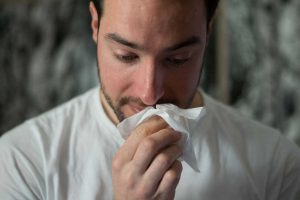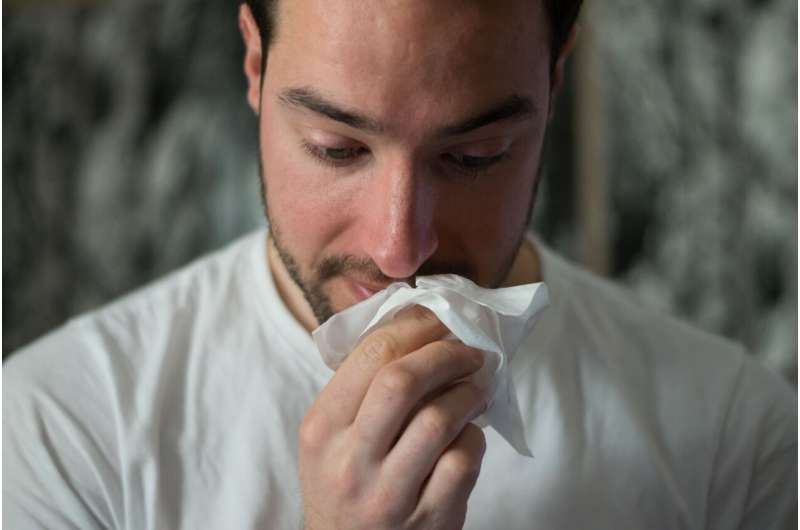Doctors say RSV is again sending people to the hospital


Doctors near Pittsburgh, Pennsylvania, have noticed a surge in patients coming into hospitals with RSV, a common virus with cold-like symptoms.
Respiratory syncytial virus is among a handful of respiratory viruses to tick up in the winter months. Last year saw what experts called a “tripledemic,” as COVID-19, influenza and RSV surged together, leading to a rise in hospitalizations around the nation.
In Pennsylvania, reported RSV cases jumped nearly 28% when comparing the week ending Dec. 2 to the week prior. Cases in Allegheny County represent about 20% of state cases for the most currently available data.
Though in many people RSV presents (and clears) as would a cold, it’s of particular concern for high-risk groups, including those over the age of 60 with chronic conditions, such as emphysema, and babies.
RSV causes between 6,000 and 10,000 deaths every year in those over the age of 65, according to a Centers for Disease Control and Prevention report, compared to about 12,000 for the flu, according to Statista.
One recent CDC report found that, for people 60 and up who were hospitalized with RSV, COVID or flu between 2022 and 2023, those with RSV were more likely to require supplemental oxygen and to be admitted to intensive care units. They also typically had existing chronic medical conditions.
RSV can be dangerous in infants who are still developing their strength and their immune systems, and is the leading cause of hospitalization in babies aged one and younger.
“Our AHN outpatient pediatric offices have seen an increase in cases of respiratory syncytial virus and influenza, which tracks with what we’re seeing nationally, and we anticipate these numbers will continue to rise this month as we gather and travel for the holidays,” said Dr. Joe Aracri, chair of AHN Pediatric Institute and a pediatrician, in a news release.
UPMC Children’s Hospital also said in an email statement that it had been seeing an increase in RSV and other respiratory illnesses over the past month, and that numbers were similar to pre-pandemic years.
Dr. Gena Walker, associate chief medical officer of St. Clair Health, said physicians there are beginning to see more adults presenting to emergency rooms and being hospitalized with RSV, adding many of them have chronic ailments, such as chronic obstructive pulmonary disease (COPD).
Last respiratory season, RSV and flu ticked up earlier in the respiratory season than usual, said Dr. Aracri. This year is more on par with pre-pandemic years, he agreed, indicating that trends are matching the seasonal fluctuation of winter viruses of years past.
“It’s back to a pattern we recognize and that pediatricians are prepared for,” he said.
RSV symptoms—runny nose, fever, cough, sore throat—can be mild and often resemble a cold. When are symptoms concerning enough to seek additional help?
Dr. Aracri outlined four main causes for concern in babies: rapid breathing, nostril flaring, belly breathing and a condition called retraction.
Rapid breathing in infants is considered breathing in and out more than 60 times a minute, said Dr. Aracri. Belly breathing can look like a child’s belly sticking out or heaving at the chest. Retraction is a term for when the ribs can be seen with each attempt at an inhale. All represent signs that the child is working harder than normal to get air. Dr. Aracri said if the child is coughing but still able to feed, they are probably OK.
“Pretty much every kid will get RSV this year,” he said. “It’s usually the kids under six months that end up getting hospitalized.”
A potential issue is the possibility that RSV progresses into a more dangerous, lower-respiratory condition.
“What tends to start as a common cold can develop into wheezing, shortness of breath or pneumonia,” said Dr. Walker.
She encouraged adults to watch for a sudden drop in their health after feeling signs of improvement from a mild infection. That can be a sign of a secondary bacterial infection, as the lungs weather inflammation from previous illness.
If you’re saying to yourself, “I felt like I was on the mend, and now I’m having fevers and my cough is worse,” it might be time to seek help, she said.
Preventative treatments now exist for RSV.
In July, the Food and Drug Administration approved Beyfortus to passively immunize babies against the virus. That means babies are given the antibodies directly; it is not a vaccine, which would prompt the body to generate its own antibodies.
The CDC announced in late October that there was a limited supply of the drug, which has led to a national shortage.
Dr. Aracri said the treatment has not been available, but that AHN is offering the RSV vaccine Abrysvo to pregnant women at 32 to 36 weeks gestation, providing protection to babies in utero. It was FDA-approved in August and shown in clinical trials to reduce the risk of lower-respiratory tract disease by 91.9% three months after birth compared to placebo. The risk of hypertensive disease preeclampsia increased by 0.4%.
Yet another RSV vaccine, Arexvy, was approved by the FDA in May, for those 60 and older. A CDC study showed it reduced the risk of severe lower-respiratory disease by 94.1%.
Dr. Aracri said he expects that the respiratory virus peak is approaching, as it typically does around January or February. Families should stay up to date with vaccination, wash hands frequently and stay home when sick, he said.
Parents can treat mild symptoms in kids with over-the-counter pain relievers, lukewarm baths and baby nasal aspirators. Emergency room care should be sought if a fever exceeds 104 degrees, 100.4 degrees in babies three months and younger, or if they are experiencing persistent vomiting and/or diarrhea.
“I would like to encourage people to stay home when they’re not feeling well,” said Dr. Walker. “You should be resting and listening to your body, but you also don’t want to put others at risk.”
Source: Read Full Article